It’s “Naked Lady” season. My husband loves them. Before you’re too shocked, they are flowers (Amaryllis belladonna), native to South Africa, but they love the environment here in New Zealand too. We don’t have any planted on our property, but fortunately a lot of other people do. So I’ve seen them everywhere lately, and they always make me smile.
We had several days of no wind, which meant I could go on long walks. (I don’t like walking in the wind – my eyes stream, even when wearing glasses, so exercise inside instead.) It was lovely being out and about in my neighbourhood. I have missed it! And I’m glad I got out before autumn really hits, even though some of the leaves on the trees are just starting to yellow.
Dinner with an old friend at a new (for me) wine bar/restaurant. She introduced me to an Asian fusion restaurant late last year near her house, and I’ve since taken The Husband there and we love it. This is a sister restaurant with a Mediterranean theme, equally as good. Of course, the conversation was as good as the food. And now I have someone new to take The Husband too.
The next morning, a coffee with a friend, chatting about our shared love of travel, followed by a sandwich on the seashore because the day was just gorgeous, and I didn’t want to come home! The sky was clear, the sea blue and calm, the weather gorgeous.
I was given a book voucher last year, and had to go into town to a particular store to spend it. That’s fine – this is the best bookstore in the whole region! I used to buy books there when our bookclub started, before we resorted to e-books. And after cleaning out a number of old handbags last year, I discovered I had about five or six loyalty cards with multiple stamps for previous purchases, meaning that I had some free books coming to me! I took them up to the counter, asking if they were still valid, knowing very well that they were at least 13 years old! (That’s how long I’ve been reading e-books.) “No problem,” they said, cheerily. “Don’t be embarrassed. We always honour them. And the most that someone has brought in was 42!” They consolidated , I walked out with two new books, knowing I have more free books to come. Such a delight.
I have a plan for a gift. There are multiple birthdays in my family/friends group coming up. My plan for one of them is causing me to smile. I can’t say anything more, but will report back.
Last but not least, yesterday I ventured over the hill to the Wairarapa, because as I implied above, I’ve been enjoying getting out of the house and the city. The point of the trip was to see a good friend. A yummy lunch and some delicious treats picked up at a French bakery before I left were the perfect backdrop to a good catch up. I listened to Stephen Fry’s Mythos on the way there and back, frequently laughing out loud – not the reaction I had expected when listening to Greek mythology. And although parts of the drive are a bit scary for this flat-lander (okay, Wellington is set amongst steep hills, but this mountain pass is another matter), I found myself actually appreciating the very active driving that is needed to safely navigate this road. Driving over the Remutaka Hill Pass road can never be passive. It always requires keen concentration, and deliberate, conscious attention and actions, taking the curves proactively rather than just following them around. Yesterday, the gusts of wind at the north-facing corners reminded me of the attention needed to ensure I didn’t hurtle off a bend and plummet to my death hundreds of metres below. Danger doesn’t usually delight me. But yesterday the trip made me feel alive.

